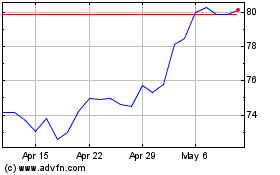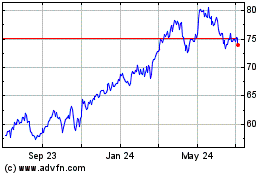Vail Resorts to Buy Stowe Mountain Resort Operations From AIG -- 3rd Update
February 21 2017 - 1:33PM
Dow Jones News
By Ezequiel Minaya and Leslie Scism
Vail Resorts Inc. said it would buy the ski operations of Stowe
Mountain Resort in northern Vermont for about $50 million from the
real-estate business of insurance giant American International
Group Inc.
Vail Resorts will acquire Stowe's ski business, related
infrastructure and machinery and summer season on-mountain
attractions. AIG will retain ownership of most of the Spruce Peak
base area, including Stowe Mountain Lodge, Stowe Mountain Club and
future development rights.
Broomfield, Colo.-based Vail has a strategy of purchasing and
improving ski areas near urban centers as way of increasing
visitors. The Stowe transaction would give the company a foothold
in the populous northeast market.
Christopher Agnew, managing director at MKM Partners, said Vail
is building an attractive network of resorts and that "this east
coast presence taps into the huge markets in Boston and New York,
and those customers will come out west as well."
Last year, Vail struck a deal to buy Canadian ski-resort
operator Whistler Blackcomb Holdings Inc. for roughly 1.4 billion
Canadian dollars. Earlier, Vail acquired the Wilmot Mountain ski
resort in Wisconsin, roughly 65 miles north of Chicago.
For its latest reported quarter, Vail said unseasonably warm
weather in November had damped early results, causing them to be
below company and Wall Street expectations. Still, the company said
colder temperatures and snowfall improved later in the month and
noted that November represented a "relatively small portion" of ski
season revenue.
Stowe has been part of AIG since the 1940s. Real estate
ownership isn't unusual in the insurance industry, with many of the
bigger insurers keeping a small slice of their investment
portfolios in property. It is a way to diversify their risk, and go
for longer-term gains than they can get with the high-quality bonds
that typically predominant.
The Stowe ski resort stands out, however, as it is has played a
role in the company's history over the years, as a vacation spot
for AIG's athletic managers. The company's involvement was the idea
of the company's founder, Cornelius Vander Starr. Though he hadn't
taken up skiing until his mid-40s, he had an "enthusiasm for sport
and an interest in real estate," according to "The AIG Story" by
longtime AIG Chief Executive Maurice R. "Hank" Greenberg, who left
the insurer in 2005 and also was an avid skier.
According to an article on Stowe's website written by a local
historian and longtime ski-patrol member, in 1943 Mr. Starr and his
wife visited Stowe and the executive was disappointed at having to
wait in line for two hours for a ride up the single chair.
Mr. Starr "offered to put up 51% of the funds for another lift,"
the website says. "Thus began AIG's involvement in Stowe which
eventually led to their ownership of the resort," the site
says.
AIG has been in the real-estate business since 1987 and built
the group into one of the world's largest property investors, with
about $25 billion in assets before the financial crisis.
The transaction is the latest move by AIG to narrow its focus to
core property-casualty and life-insurance businesses. The company
is using proceeds from many of the divestitures to finance an
ambitious two-year plan to return $25 billion to shareholders
through stock repurchases and dividends. As of early February, AIG
was more than halfway to the goal.
The divestiture program began as an effort to repay U.S.
taxpayers for a nearly $185 billion bailout during the 2008-09
financial crisis. AIG fully repaid the government by the end of
2012, and had shrunk to about half it precrisis size in terms of
total assets on its balance sheet. Even as it shrank, AIG remained
one of the world's biggest sellers of insurance to businesses, by
market share.
Now, Chief Executive Officer Peter Hancock is trying to sell
additional businesses, reduce expenses and make changes in the
insurance-product mix in a bid to boost profitability. The
management team is trying to satisfy activist shareholders Carl
Icahn and John Paulson, who in 2015 publicly called for AIG to
break into smaller pieces. Last year, Mr. Paulson and a
representative of Mr. Icahn joined AIG's board.
Earlier this month, Mr. Hancock's plan suffered a setback when
fourth-quarter results badly disappointed, in large part because of
an unexpectedly large $5.6 billion boost to the company's
property-casualty claims reserves. The company also announced that
two profitability targets set for accomplishment by year-end
wouldn't be achieved then.
In another real estate deal, AIG Global Real Estate announced in
November it had completed the sale of the International Finance
Centre Seoul to Brookfield. Terms of the transaction weren't
disclosed.
Write to Ezequiel Minaya at ezequiel.minaya@wsj.com and Leslie
Scism at leslie.scism@wsj.com
(END) Dow Jones Newswires
February 21, 2017 13:18 ET (18:18 GMT)
Copyright (c) 2017 Dow Jones & Company, Inc.
American (NYSE:AIG)
Historical Stock Chart
From Mar 2024 to Apr 2024

American (NYSE:AIG)
Historical Stock Chart
From Apr 2023 to Apr 2024
